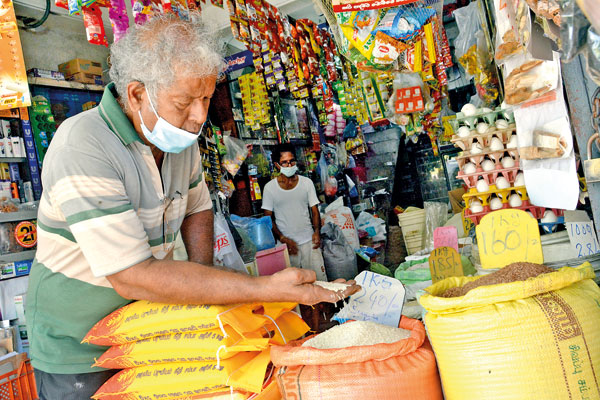News
50% fall in paddy yield points to necessity to import 1 mn metric tonnes of rice
A paddy shortage by the end of February is now inevitable and the Government will have to import 800,000 to one million metric tons of rice to avoid scarcity during the April Sinhala and Tamil New Year, small and medium-scale rice mill owners said this week.
There were dire predictions that the upcoming Maha season will yield 50 percent less paddy than usual. The fertiliser shortage points to these coming true. And there is a scramble to import stocks amidst a worsening forex crisis.
Small and medium-scale rice mill owners say that by the Sinhala and Tamil New Year Season,
the price of a kilo of rice will exceed Rs.300. Pic by M.D. Nissanka
“The Government must evaluate the rice scarcity effectively and prepare a buffer stock,” urged Muditha Perera, President of the United Rice Growers’ Association. “This assessment has not yet been made. It is important to send agronomists to the field now to assess the severity of the scarcity.”
During the Maha season, the market typically receives around three million metric tons of paddy. With the sudden fertilizer shortage, however, crop reductions became unavoidable. Mill owners estimate that only 1.5 million to 1.7 million metric tons of rice will be delivered to the market this season.
The working capital of small and medium-scale rice mill owners is insufficient to purchase paddy this season in comparison to the same period last year, Mr Perera said.
“We bought 1kg of paddy for Rs.50 last year, but we now have to buy 1kg of paddy for Rs.100,” he narrated. “We don’t have the working capital to continue purchasing paddy at these rates, so our manufacturing capacity has been cut in half. This decrease is also causing a rice shortage in the market.”
Harvesting is ongoing in Kilinochchi, Ampara, and Trincomalee, with farmers reporting a half-percentage-point reduction in the yield compared to the same period last year. The Government decided to import 400,000 metric tons of rice, Trade Minister Bandula Gunawardena said, adding that plans to artificially and unjustly raise the price of rice will not be allowed.
“Throughout the year, we will provide 1kg of Nadu rice for less than Rs. 105 and a kilo of Super Samba rice for less than Rs. 130,” he vowed. “Consumers will be able to get these products through Sathosa, Co-operatives, Q-Shop, and other state marketing networks at these costs.”
Cabinet has approved importation of 200,000 metric tons of nadu rice and 100,000 metric tons of samba rice. The Government has also signed an agreement with the Burmese Government for another 100,000 metric tons of raw rice stocks, expected to arrive next month. The Finance Minister and Central Bank were consulted regarding the possibility of importing rice through the private sector, as well. The Ceylon Chamber of Commerce had signed all the Memorandums of Understanding (MoUs) and issued Letters of Credit (LCs) for the import of nadu and super samba rice from India and raw rice from Burma.
Last week, small and medium-scale rice mill owners also predicted that by the Sinhala and Tamil New Year Seasons, the price of a kilo of rice will exceed Rs.300. But there is a noticeable decrease in widely consumed rice, such as nadu and kekulu rice, in the market.
Verite Research, an independent think-tank, conducted a telephone survey in July last year involving 1,042 farmers countrywide on the banning of chemical fertilizer and its expected impact.
Over ninety percent of farmers surveyed had used chemical fertilizer at that time and almost all of them (85%) expected a huge reduction in their harvest due to the ban, Subhashini Abesinghe, an Economist and a Verite Research Director said.
Paddy farmers were the most reliant on chemical fertilizers (94 percent), followed by tea and rubber growers (89 percent), she said. Indicating the lack of confidence in the expertise required for the changeover, Ms Abeysinghe said only twenty percent of farmers indicated they had appropriate knowledge on organic fertilizer and how to apply them properly in their crops.
The best way to say that you found the home of your dreams is by finding it on Hitad.lk. We have listings for apartments for sale or rent in Sri Lanka, no matter what locale you're looking for! Whether you live in Colombo, Galle, Kandy, Matara, Jaffna and more - we've got them all!

